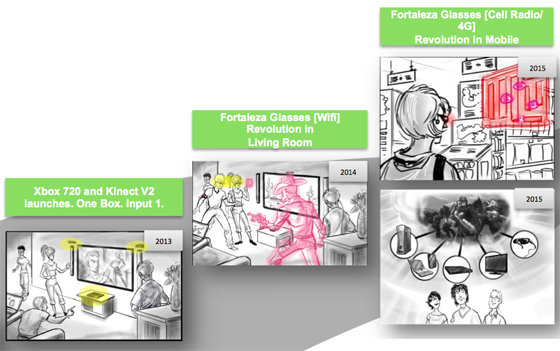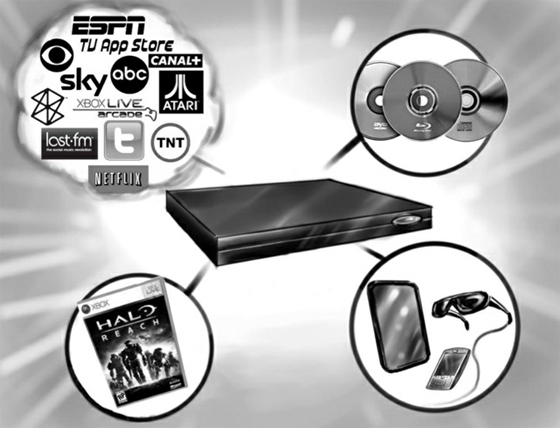According to a 56-page document that an anonymous uploader posted to scribd.com — and has since been removed at the request of law firm Covington & Burling — Microsoft is planning a $299 Xbox 720 with Kinect 2 for a holiday 2013 release. Microsoft supposedly drafted the outline, which contains a road map for the company’s Xbox division through 2015, in mid-2010. This document’s authenticity has not been verified, but Convington & Burling LLP is Microsoft’s legal counsel.
An included spec sheet for the Xbox 720 details the unit’s innards. The system will operate on six to eight ARM/Intel x86 cores running at 2Ghz with 4GB of memory. Software will ship on dual-layered Blu-rays for 50GB of optical storage. Microsoft’s new box will also feature 3 PowerPC cores for full backwards compatibility with Xbox 360 games. These obtuse specifications amount to a box that is six to eight times more powerful than the current hardware.
Forward-looking engineers at Redmond, according to the leaked documents, are arranging the console to be a “modular design [in order] to facilitate SKU updates later in [the] lifecycle.”
Always-on low-processing-power functionality will also factor into the use of the system. Similar to how a set-top box from Comcast or Time Warner is never truly powered down, the Xbox 720 will be able to act as your home’s media hub by recording shows in the background. A separate dual-core cluster of chips will handle this background workload and will ensure that gaming performance is not affected.
Oddly, the spec sheet lists cellular compatibility with the Wimax and HSDPA architectures. These are the mobile-phone standards used by Sprint, T-mobile, AT&T and others. Maybe the $99 Xbox 360 with a two-year contract will also come with AT&T 4G for some reason.
Kinect 2 and Project Fortaleza (Kinect glasses)
When the Xbox 720 launches in 2013, according to this unconfirmed information, it will come bundled with the Kinect 2. An “incremental” upgrade to the current motion controller, the Kinect 2 will allow four players to simultaneously waggle at their television. It will feature a dedicated hardware processor, a more accurate camera, and a higher-quality microphone for voice recognition. Smaller apartments will also be able to get in the mix, as the Kinect 2 will be equipped to deal with spaces that are closer, wider, and deeper. Also, and here’s the megaton, Kinect 2 can be controlled by players that are sitting down.
A new project, dubbed Project Fortaleza, which is basically Kinect glasses, will launch in 2014. The glasses will be a wearable computer that act much in the same way as Google’s Project Glass. The goggles will augment reality with an interactive digital overlay. Microsoft will initially pitch this as a way to enhance gameplay, but intends for a 4G cellular version to ship for every-day use by 2015.
Cloud gaming
If this document is real, it all but confirms that this will be the last Microsoft console. The company hopes to implement complete cloud streaming of games by 2015. The analysis says consumers will “”never need to upgrade hardware again.”
The document mentioned OnLive as a possible acquisition target. Microsoft labeled the game-streaming company as a threat with the potential to “up-end the console-gaming market by making expensive consoles and PCs unnecessary for AAA gaming.” Microsoft may choose to neutralize them by absorbing this already established company rather than creating a cloud-streaming service from scratch.
What does it mean?
We’ve contacted Microsoft to confirm if this information is real. Expect the typical, “we do not comment on rumor and speculation.” We do know, however, that Covington & Burling represents Microsoft, so the company was at least responsible for the documents removal. That does not confirm its authenticity.
If this is the truth, however, it spells trouble for Nintendo and Sony. A $299 Xbox 720 with Kinect 2 and all the bells and whistles could own the living room. It may even be enough to compete with Apple. The next consumer-electronic battlefront is for the box under the TV. That’s where the majority of content is going to be purchased, and whoever owns that bridge will be able to collect a hefty toll. Still, we’ll be surprised if 100 percent of this information makes the transition to reality.
VentureBeat's mission is to be a digital town square for technical decision-makers to gain knowledge about transformative enterprise technology and transact. Learn More




